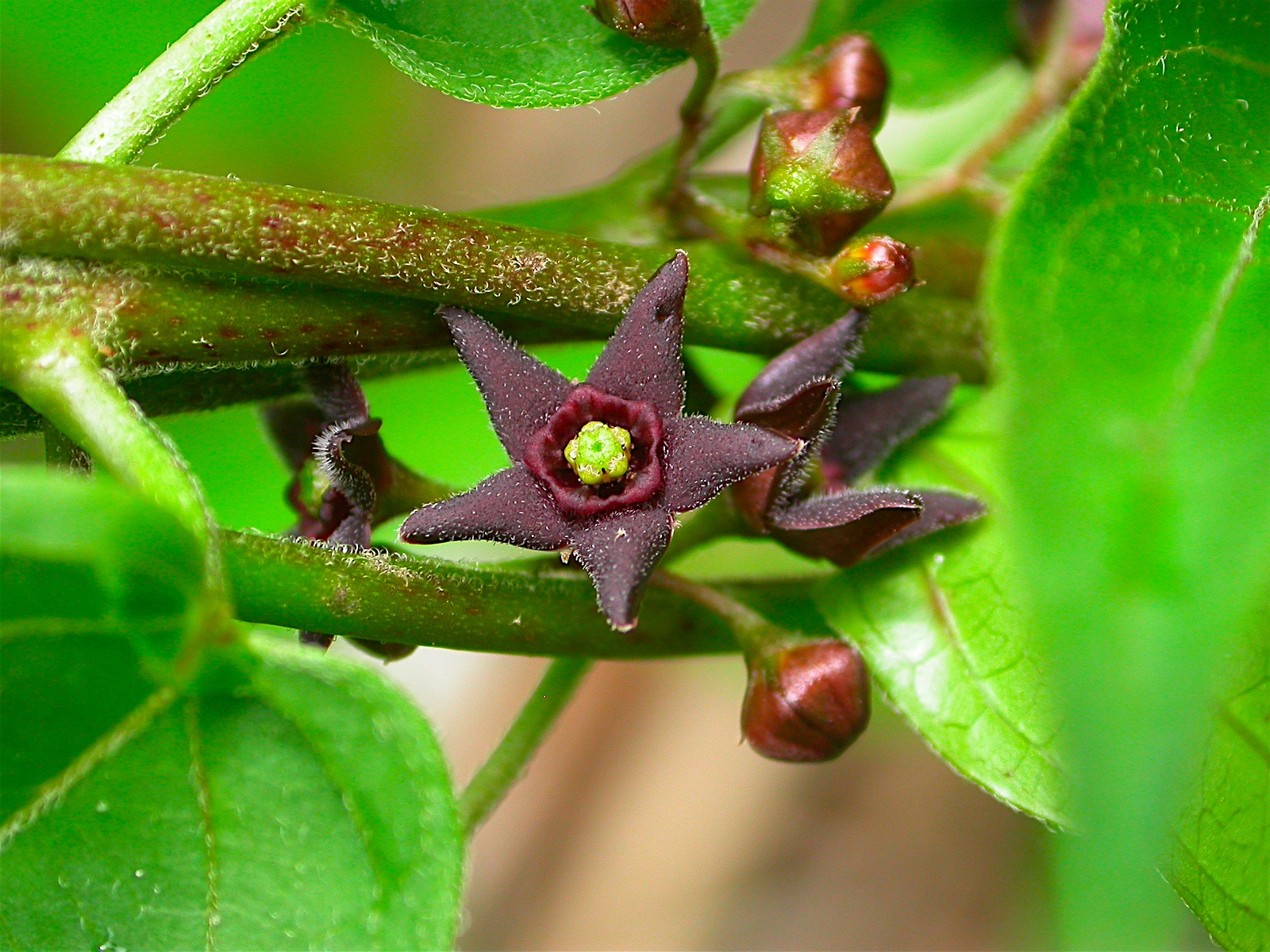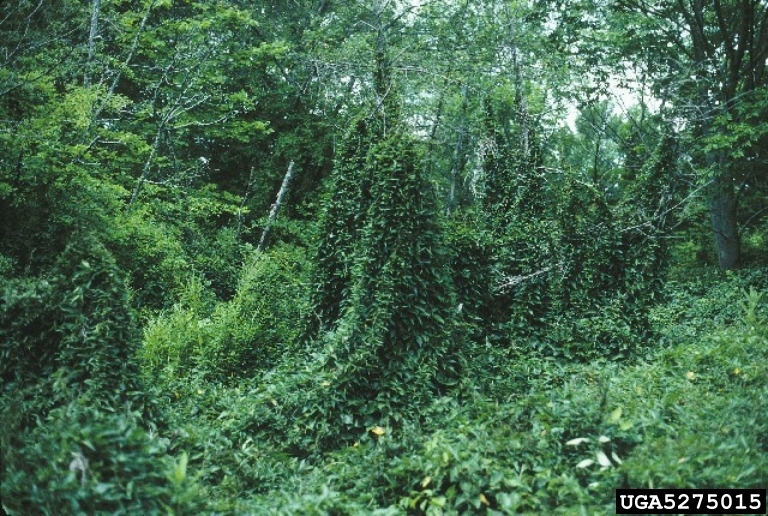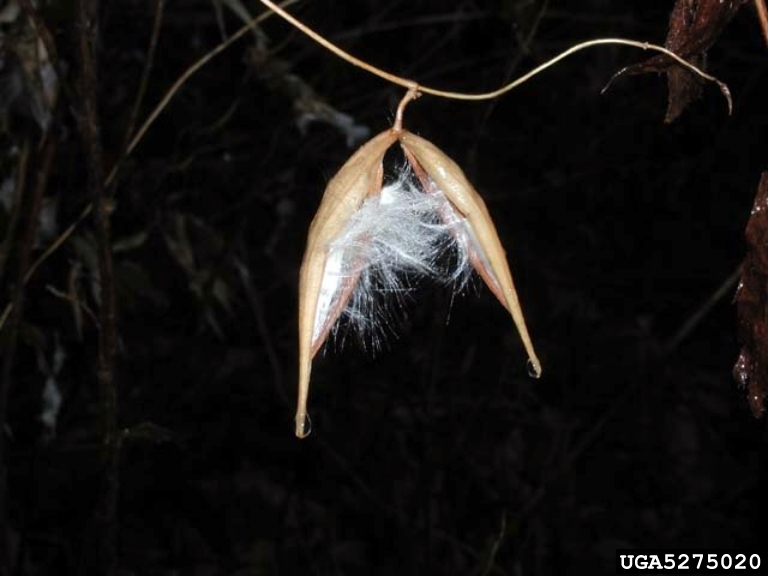 Download PDF
Download PDF
Name: Vincetoxicum nigrum (L.) Moench.
Family: Apocynaceae (the Dogbane family), formerly separated as the Asclepiadaceae (Milkweed family) (1,12). Here we accept the larger Apocynaceae.
Common Names: Louis’ swallow-wort, black swallow-wort, climbing milkweed, black dog-strangling vine, Louise’s swallow-wort, climbing poison, and dark vincetoxicum. The French common name is dompte-venin noir, which translates roughly to “black venom-subduer” (1,4,7,15).
Etymology: Two explanations exist for “Vincetoxicum”. DiTommaso et al.(7) explain that it comes from the Latin Vinco and toxicum, and means “to overcome or subdue [with] poison.” Fernald (13) says that Vincetoxicum is “an ancient name, meaning rope-like poison.” The common name possibly refers to a possible past use of the plant as an animal poison. Still, it was once said to be an antidote for poisons (7). The earlier generic synonym Cynanchum, comes from the Greek words kyon, meaning “dog”, and anchein, meaning “strangle” or “poison.” Nigrum is Latin for “black” (7).
Botanical synonyms: Cynanchum nigrum (L.) Pers., non Cav., Cynanchum louiseae Kartesz & Gandhi (1), Asclepias nigra L. (3)
Quick Notable Features:
¬ Deep purple flowers borne in axillary cymes
¬ Adaxial petal surfaces covered in hairs
¬ Simple, opposite, petiolate leaves
¬ Stems reddish where exposed to constant sunlight
Plant Height: Stems typically grow 0.4-2m long, and can twine to a height of 0.6-1.5m (3,4,7).
Subspecies/varieties recognized: none (5)
Most Likely Confused with: Lonicera spp., Solanum dulcamara, Vincetoxicum rossicum
Habitat Preference: Fields, thickets, roadsides, fencerows, and waste areas (4). The species thrives under low or high light exposure (7). “Well-drained, stony soils are often densely colonized” (7).
Geographic Distribution in Michigan: Previously reported in only seven counties in the Lower Peninsula: Genesee, Hillsdale, Ingham, Kalamazoo, Lenawee, St. Joseph, and Washtenaw (1). V. nigrum was been confirmed in four additional counties in 2011: Calhoun, Cheboygan, Clinton, and Emmet (14).
Known Elevational Distribution: In the European Pyrenees, V. nigrum has been observed to grow up to elevations of 500m (7). In Spain, it was collected at 1980m above sea level on Pico de los Tejos, in the Sierra de Castril (15).
Complete Geographic Distribution: Native to southwestern Europe (Portugal, Spain, France, and Italy) (7), V. nigrum is now found in all of the Great Lakes states, as well as Maine, Vermont, New Hampshire, Connecticut, Massachusetts, Rhode Island, Maryland, Kentucky, Missouri, Kansas, Nebraska, and California. In Canada, it is found in Ontario and Quebec (1). There are also occurrences of the species in Albania, Germany, Mexico, Netherlands, and Sweden (15).
Vegetative Plant Description: A perennial herbaceous scrambler, erect forb, or twining vine that over-winters as short, horizontal rhizomes. The roots are pale and fleshy, and the stems are slender, with latex. The stem pubescence may be arranged in lines. The stems are usually green but can turn reddish-brown when exposed to constant light. The opposite leaves are ovate or lanceolate with acuminate tips and round bases, 3-12cm long and 1.5-7.5cm wide, borne on petioles 10-20mm long. Leaves are dark green with red, pubescent, pinnate veins, surfaces glabrous above and pubescent below (especially along midrib). Leaf margins are entire; they are usually flat but sometimes slightly revolute, and ciliate. Leaves are described as largest and roundest in the center of the vine, with basal leaves and apical leaves tending to be smaller and narrower (2,3,4,6,7,8).
Climbing Mechanism: Stem apices twine or scramble (4,7). Although no literature on twining direction was found, photographs (13) suggest V. nigrum twines dextrally (left to right).
Flower Description: The fragrant 5-merous flowers (5-9mm across) are borne in axillary cymes. The peduncles are typically curved, pubescent (pubescence sometimes arranged in linear bands), 0.5-4cm long, bearing 4-12 flowers each. The pedicels are slender, glabrous or densely pubescent, and up to 4mm long. The sepals are ovate or triangular, 1-2mm long. The deep purple or brown petals are 1.5-3mm long and broad, and the adaxial surfaces are coated in fine white hairs. The petals are not twisted within the bud, unlike many Apocynaceae. V. nigrum has a corona (staminal crown); it is approximately 0.5mm tall, 5-lobed, and often grows higher than the superior, sessile, yellowish-green, 5-staminate gynostegium (a fusion of the androecium that covers the gynoecium). The anthers are inconspicuously winged. The ovary is two-carpellate (2,3,4,6,7,8,12).
Flowering Time: In New York, V. nigrum flowers from May through mid-June (7), while throughout the range the flowers can be seen through September (13).
Pollinator: V. nigrum is pollinated by flies and selfing (7). One study found that flowers visited by flies produced more viable seeds than self-pollinated flowers (7).
Fruit Type and Description: The species bears glabrous or pubescent follicles 4-8cm in length, slender or plump, occasionally paired, and without nodules on the exocarp. V. nigrum fruits in early August to early October in the northern U.S. (4,6,7,8).
Seed Description: Seeds are produced from August to October in the northern U.S. Seeds are small, brown, flat, ovoid, 6-8mm long and 3-5mm wide, and tipped in silky hairs 2-3cm long (4,7).
Dispersal Syndrome: The follicles open; the silky seeds are carried away on the wind (4,7).
Distinguished by: Many Apocynaceae, including Vincetoxicum can easily be distinguished from most other families by the presence of milky latex in the stems, and no climbing Lonicera species found in Michigan has latex in its stem. V. nigrum may be distinguished from Solanum dulcamara by its opposite, entire leaves (Solanum has alternate, serrated leaves) and fruit (V. nigrum has a follicle; S. dulcamara has a bright red berry).
In contrast to V. nigrum, Vincetoxicum rossicum has pale pink, occasionally maroon flowers, with glabrous petals as least twice as long as wide. V. nigrum bears dark purple petals that are as long as wide, with adaxially pubescent surfaces. Additionally, the flower buds of V. rossicum are conical, whereas the flower buds of V. nigrum are globose. Finally, the linear bands of hair on the stems of V. rossicum are much more distinct and dense than the bands of pubescence on V. nigrum.
Other members of the family in Michigan: Asclepias (12) and Vincetoxicum (1) in the subfamily, and Apocynum (3) and Vinca (2) in the full Apocynaceae (source: 1).
Ethnobotanical Uses: None found, with the exception of the proposed etymology: the synonym Cynanchum possibly refers to a possible past use of the plant as an animal poison. Interestingly, the Latin Vinco and toxicum, from which came the synonym Vincetoxicum, roughly means “to overcome or subdue with poison”; V. nigrum was once said to be an antidote for poisons (7,10,11).
 Phylogenetic Information: Apocynaceae and Asclepiadaceae are sometimes treated as distinct families, but have been merged by many workers since 1962, with Asclepiadoideae as one of five subfamilies within Apocynaceae. Several differences exist (as well as similarities) between the two old families, but a few distinguishing characters may be useful in the field: corolla shape (generally rotate in Asclepiadoideae and funnelform or salverform in Apocynaceae, and filament fusion (typically connate in Asclepiadoideae, and distinct in Apocynaceae). The Apocynaceae is placed in the Gentianales, within Asterid I group of the angiosperms (12).
Phylogenetic Information: Apocynaceae and Asclepiadaceae are sometimes treated as distinct families, but have been merged by many workers since 1962, with Asclepiadoideae as one of five subfamilies within Apocynaceae. Several differences exist (as well as similarities) between the two old families, but a few distinguishing characters may be useful in the field: corolla shape (generally rotate in Asclepiadoideae and funnelform or salverform in Apocynaceae, and filament fusion (typically connate in Asclepiadoideae, and distinct in Apocynaceae). The Apocynaceae is placed in the Gentianales, within Asterid I group of the angiosperms (12).
Interesting Quotation or Other Interesting Factoid not inserted above: Several species of butterfly, including North American monarchs (Danaus plexippus), lay their eggs only on members of the Asclepiadoideae. Although some butterfly species show a clear preference for non-toxic Asclepiadoideae members (primarily Asclepias) when they are available, some butterflies have been observed to lay eggs on V. nigrum, raising concerns about the survival of the populations due to the toxic nature of compounds within V. nigrum and its recent rapid spread (9). The species is listed as an invasive weed in many parts of its current range (13).
Literature and websites used:
- USDA, NRCS. 2008. The PLANTS Database, Version 3.1, National Plant Data Center, Baton Rouge, LA 70874-4490 USA. http://plants.usda.gov/ (retrieved December 1st, 2008)
- Lawlor, F. 2006. Plant Conservation Alliance’s Alien Plant Working Group: Cynanchum louisease. http://www.nps.gov/plants/ALIEN/fact/cylo1.htm. (retrieved December 1st, 2008)
- Gleason, H.A. 1963. The New Britton and Brown Illustrated Flora of the Northeastern United States and Adjacent Canada. New York, New York, USA: Hafner Publishing Co., Inc.
- Georgia, A.E. 1914. Manual of Weeds. New York City, NY, USA: McMillan Company.
- ITIS: Integrated Taxonomic Information System. http://www.itis.gov/index.html. Retrieved December 1st, 2008, from the Integrated Taxonomic Information System on-line database.
- Britton, N.L. 1901. Manual of Flora of the Northern United States and Canada. New York City, NY, USA: Henry Holt and Company.
- DiTommaso, A., F.M. Lawlor, & S.J. Darbyshire 2005. The Biology of Invasive Alien Plants in Canada, Cynanchum rossicum (Kleopow) Borhidi [= Vincetoxicum rossicum (Kleopow) Barbar.] and Cynanchum louiseae (L.) Kartesz & Gandhi [= Vincetoxicum nigrum (L.) Moench]. Canadian Journal of Plant Science 85: 243-263.
- McGregor, R.L. 1986. Flora of the Great Plains. Lawrence, Kansas, USA: The University Press of Kansas.
- Casagrande, R.A. & J.E. Dacey. 2007. Monarch Butterfly Oviposition on Swallow-Worts (Vincetoxicum spp.). Environmental Entomology 36: 631-636.
- Plants For A Future, 1996-2003. Last modified: June 2004.
- Moerman, D. 2006. Native American Ethnobotany. University of Michigan – Dearborn. http://herb.umd.umich.edu/
- Zomlefer, W.B. 1994. Guide to Flowering Plant Families. Chapel Hill, North Carolina, USA: The University of North Carolina.
- Uva, R., J.C. Neal, & J.M. DiTomaso. 1997. Weeds of the Northeast. Ithaca, New York: Cornell University Press.
- Michigan Flora Online. A.A. Reznicek, E.G. Voss, & B.S. Walters. February 2011. University of Michigan Herbarium, January 2014. http://michiganflora.net/species.aspx?id=167.
- Gbif.org. Global Biodiversity Information Facility Website. Accessed: 03 December 2013.
Image Credits (all used with permission):
1) Image of leaves and flowers courtesy Leslie J. Mehrhoff, University of Connecticut/bugwood.org (http://www.invasive.org/browse/detail.cfm?imgnum=5275013)
2) Image of flower is from Pieter at Picasa photos http://picasaweb.google.com/pelserpb
3) Image of habit with extensive growth is courtesy of Leslie J. Mehrhoff, University of Connecticut/bugwood.org (http://www.invasive.org/browse/detail.cfm?imgnum=5275015)
4) Image of fruit with seeds dispersing courtesy Leslie J. Mehrhoff, University of Connecticut/bugwood.org (http://www.invasive.org/browse/detail.cfm?imgnum=5275020)
5) Species distribution map, derived from the Michigan Flora Online.
Primary Author: ReBecca Sonday and John Bradtke, editing by Robyn J. Burnham & Cristine V. Santanna
© Robyn J. Burnham
For additional information on these web pages please contact Robyn J. Burnham via email: rburnham“at”umich.edu